
Branching out for Fibre
April 22, 2010
By
Heather Hager
The pellet plant in Middle Musquodoboit has an unusual history. The Nova Scotia facility began its life as a late addition to the former MacTara lumber mill, as a value-added way to dispose of sawdust and bark from the two sawmills.
The pellet plant in Middle Musquodoboit has an unusual history. The Nova Scotia facility began its life as a late addition to the former MacTara lumber mill, as a value-added way to dispose of sawdust and bark from the two sawmills. Affected by the lumber downturn and closed due to bankruptcy in 2007, the entire mill assets were purchased in 2008 by Enligna, a Germany-based renewable energy company. The sawmills remain silent, but the pellet plant is producing more than ever, thanks to a major makeover to the wood supply chain and a recent facility expansion.
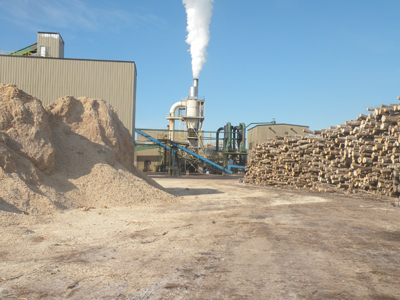 |
| With less sawdust available from sawmills, the Enligna pellet plant runs on a variety of biomass sources, including off-species and deadwood from timber harvesting. A large plume of steam is produced as the biomass moves through the dryer.
|
“The pellet plant did not have enough fibre because the supply chain was dependent on the sawmill,” explains Fraser Gray, president of Enligna Canada. So the Enligna team had to develop an entirely new strategy for obtaining a sufficient supply of raw materials from which to make pellets. Fibre now arrives from a variety of previously untapped sources, giving diversity and stability to the operation.
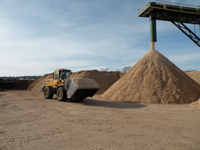
|
| A loader operator feeds the boiler and pellet plant with biomass mixtures as bark arrives from Enligna’s chipping operation. Advertisement
|
About half of Enligna’s fibre is obtained on the open market from logging contractors and private landowners. But it’s not high-quality softwood, which is too valuable and thus uneconomical to make into pellets. It’s mostly hardwood, off-species such as poplar and aspen, and deadwood. Because the Maritimes’ Acadian forest comprises a mixture of softwood and hardwood, landowners want to harvest the valuable softwood, but they’re often left with a lot of material that’s not marketable. That’s where pellets fit into the supply chain, says Gray. “We will work with any low-grade or off-grade forest products.”
Another 30% of the fibre comes from purchased bark and byproducts from local sawmills. This currently comes from six or seven sources, says Gray. For example, Taylor Lumber, which is just a few kilometres down the road, will sell the extra bark or sawdust that it doesn’t use for its own 1-MW cogeneration plant.
Another 10% is bark from Enligna’s softwood debarking and chipping operation, which was also part of the original lumber mill. Enligna has continued the chipping operation because it’s simple and straightforward, explains Gray. The chips supply Northern Pulp, a kraft pulp mill in nearby Pictou County. The waste bark supplies the pellet plant as both fibre for pellets and hog fuel for the biomass furnace that dries the fibre.
 |
| Fraser Gray, who joined the Enligna team in early 2009 as president, is no stranger to the business, having spent 11 years in senior forest sector roles. |
The remaining 10% of the fibre comes from a small Crown licence obtained in late 2008. The softwood from that cut is sold to sawmills or chipped for pulp, and the hardwood, off-grades, off-species, and deadwood are made into pellets. “The only reason it’s economical for us to harvest is because we get to sell the high-grade sawlogs to other mills, which offsets our costs,” says Glenn O’Connor, vice-president timberlands operations, who manages fibre procurement. “We’d be better off buying wood on the open market than cutting our own if we didn’t [do that].”
“It’s quite a mixture of sources, but it should be,” says Gray. “We have to work with what the market will give us.” He says that pellet producers can only afford a certain cost of input materials and that making softwood sawlogs into pellets would disrupt the rest of the forest industry. “But, the economics of it drive a lot of it anyway, which keeps it sensible,” he concludes.
Demand dictates supply
With such a diverse supply of fibre, Gray stipulates that the first consideration in making pellets is how to meet consumers’ needs for consistent pellet specifications. For export to Europe, where about 99% of Enligna’s product goes, wood pellets must meet or surpass specific DIN standards that dictate pellet characteristics such as maximum levels of fines and ash. Industrial export markets want less than 3% ash, whereas users of premium pellets, e.g., for home heating, require less than 1% ash.
Of the input materials, sawdust and hardwood have very low ash content, at less than 1%. Poplar and aspen are also low in ash, at about 1%, but must be combined with other types of wood to make a pellet that holds together. Bark has the highest ash content, at 3% or more, so it must be blended with whitewood to reduce the ash content. “We use different recipes or blends of materials, depending on the required production results,” explains O’Connor. But the available supply of materials doesn’t dictate what they produce. “We buy in accordance to our production; whatever the pellet market wants is what we’ll buy for raw material.”
Recipes for success
Enligna expanded its production in the fall of 2009, with the help of a $2.5-million loan through Nova Scotia Business Inc. Several changes and additions were made to increase the production capacity from 80,000 to 105,000 tonnes/year. These included reconfiguring the yard to facilitate material handling, adding a chipper, upgrading and adding pelletizers, adding a new cooling system, and upgrading the computer operating system.
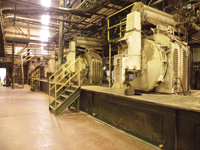 |
| Andy Wright, vice-president operations, has found that the die lifespan in these Sprout pellet mills can range from 600–1000 tonnes/die for pellets containing bark to 1000–1400 tonnes/die for whitewood pellets.
|
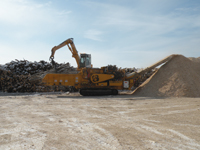 |
| The new CBI grinder with chipping rotor allows the plant to start with small and fairly uniform raw material. The plant was originally designed to work with sawdust. |
The change from using bark as the main fibre source to using a variety of materials involved a bit of learning on the material handling side, says O’Connor. At first, they tried chipping or grinding the logs into large storage piles as the wood arrived at the mill. Now, the logs are stored whole, segregated by species. This reduces the chance of spontaneous combustion fires starting in chip piles and helps minimize moisture accumulation due to snow, ice, and rain. And keeping the species, and the deadwood, segregated helps in the manufacturing process by allowing better knowledge of the fibre’s moisture content. “You can make pellets out of anything, you’ve just got to know what you’re making them out of,” says O’Connor.
Logs are chipped about a day ahead of the fibre’s use and according to the type of pellets being made. To keep up with production, the company recently purchased a CBI Magnum Force 6400 horizontal grinder with chipper rotor, along with a Liebherr 904 material handler to feed the machine. The chipper rotor has had major benefits, says Andy Wright, vice-president operations, who oversees the day-to-day functioning of the facility. It produces quarter-inch (about 6-mm) pieces that are cut across the grain, facilitating the drying process, as well as the fibre’s pulverization further down the line.
Bark from the three Valon Kone 550 ring debarkers at the pulp chipping operation arrives by conveyor from across the road, and two Volvo L90D front-end loaders move that and the chipped fibre to two infeed bins. One bin is fed with bark to fuel the 70-million-BTU GTS Energy biomass furnace and high-pressure boiler for drying the pellet material. The other is fed bucket-loads of the various fibre types in specific proportions to make industrial or premium pellets. Here, the loader operators play a key role in maintaining the proper blend to produce consistent pellets, says Wright.
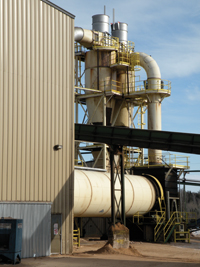
|
| Hot air from the biomass furnace passes through the M-E-C dryer along with raw biomass for pellets and then through a group of cyclones to remove particulates before leaving the stack as steam.
|
Fibre fed into the pellet production line first passes through a Jeffrey 66WB green hog, which reduces the particle size. The material is then conveyed to an M-E-C triple-pass dryer, where the moisture content is reduced from 35–65% to 6–8%. From there, it passes through an Oliver destoner, which removes heavy knots and rocks, before going to 500-hp Andritz Sprout-Matador hammermills to be pulverized. Because the raw fibre consists of bark, and because of harvesting conditions in the forest, destoning is especially critical, as the crew found out early on. Stones that get into the hammermills can cause sparks during the hammering process, creating a serious fire hazard. “We didn’t install the destoner initially, and we had trouble with sparks in the hammermills due to the stones. We quickly realized that we needed a destoning process and that we had to be more particular in raw material procurement,“ says Wright.
From the hammermills, which are to be upgraded in June 2010, the wood dust goes to Andritz Sprout-Matador pellet mills, where it is extruded through dies to form the pellets. During the plant’s expansion, three of the four original mills were upgraded from 300 to 400 hp, one was replaced entirely, and a fifth 400-hp mill was added to the fleet. The pellets, which are warm from the extrusion pressure, are conveyed to a Law-Marot Milpro pellet cooler, where they are cooled to ambient temperature. A Sprout screener then removes fines. This new, higher capacity cooling and screening equipment was installed during the expansion to relieve a bottleneck in the process, says Gray. The finished pellets then go to a bulk storage bin with 300 tonnes of capacity.
Co-ordinating and monitoring of the whole pelleting process occurs in the central control room, which is essential to maintaining the process flow. The computer systems monitor critical elements such as furnace temperature, dryer temperature, and material flows. This is particularly important to maintain consistency in the fibre exiting the dryer to ensure proper system function and product quality. “You want consistent dryer temperatures,” says Wright. “That changes with variations in the moisture content of the material being dried, as well as the fuel material.” The control room also closely monitors sparks in the process, via a Grecon spark-detection system. If the system detects that a spark threshold is exceeded, automatic fire extinguishing systems are activated, and the fibre in that particular area is diverted to an exterior dump station.
Tapping the markets
Depending on the season, the rate of pellet production can fill the on-site storage within 16 to 18 hours. So co-ordinating the trucking of pellets to off-site storage is critical, says Wright. “There is very close communication between us and our trucking firm, Gerald Battist Trucking, who has hauled our pellets for several years,” says Wright. The trucks haul the majority of pellets to the Halifax Grain Elevator at the Port of Halifax, from where the pellets are shipped in bulk to European customers.
The company is also testing the waters of the domestic pellet market. “We just entered the domestic bagged market in 2009,” says Gray. “That market went short last year, which is a little silly considering we’re here with all these pellets.” This market was only a small fraction of production, about 1000–1200 tonnes, so the bagging was done at the Agromart facility in Truro. In addition, pellets are sold in bulk to several local greenhouses that have converted from coal and other sources, as well as to some institutions in Prince Edward Island that have begun heating with pellets.
For the future, Enligna is looking at the possibility of having its raw material for pellets certified by a third-party organization such as the Sustainable Forestry Initiative (SFI) or the Programme for the Endorsement of Forest Certification (PEFC, formerly the Pan-European Forest Certification Council), says O’Connor. “Most of the material that we buy from the sawmills is SFI material already. We can verify that the wood we’re using is SFI, but our material from private suppliers is not SFI certified.” Some of Enligna’s pellet customers already have their own sustainability criteria that their suppliers must meet, and O’Connor thinks that more customers will be looking for sustainability certification.
“Forest certification is going to be the norm,” O’Connor predicts. “If you don’t have it, you’re not going to be in the market.”
Print this page